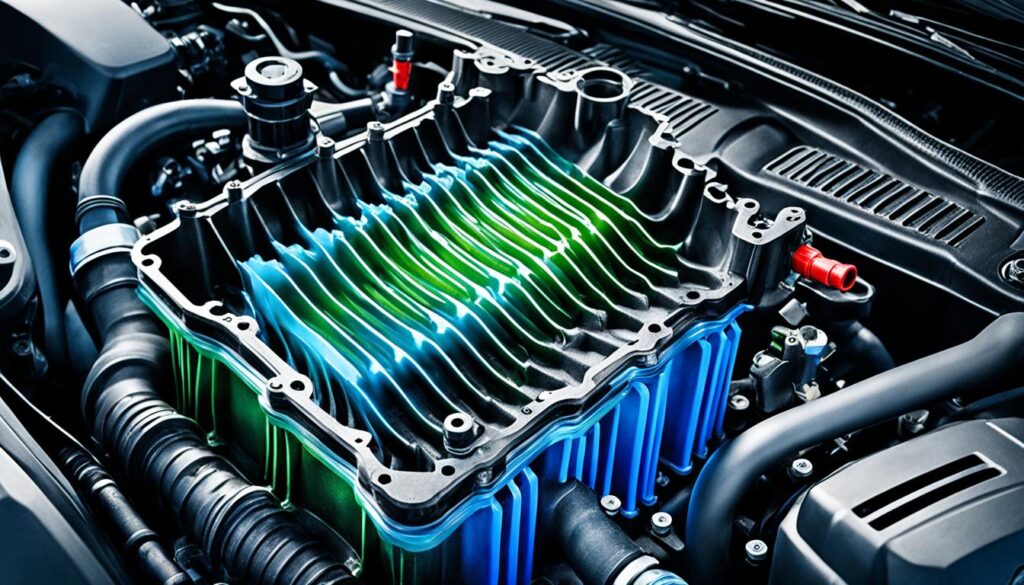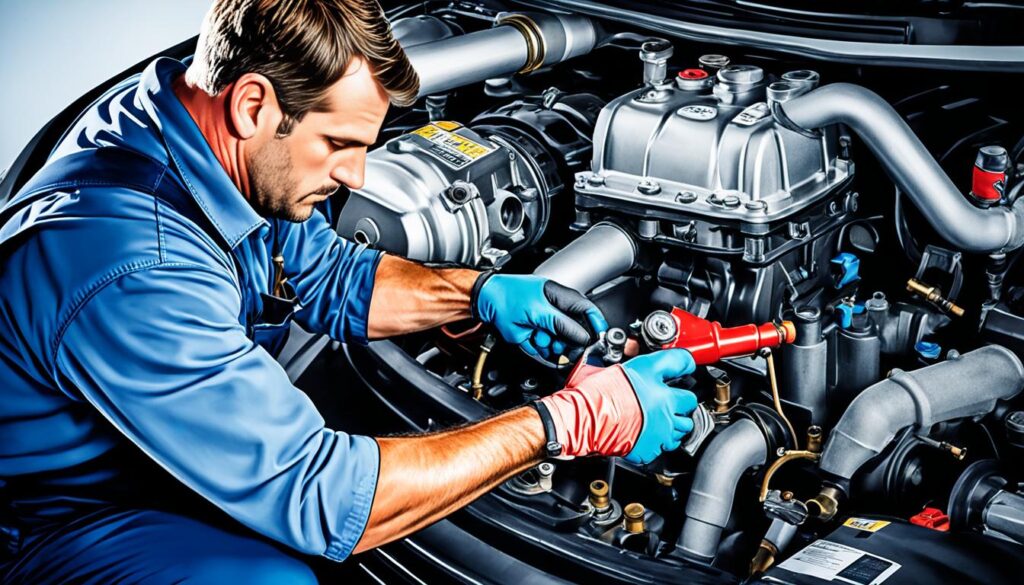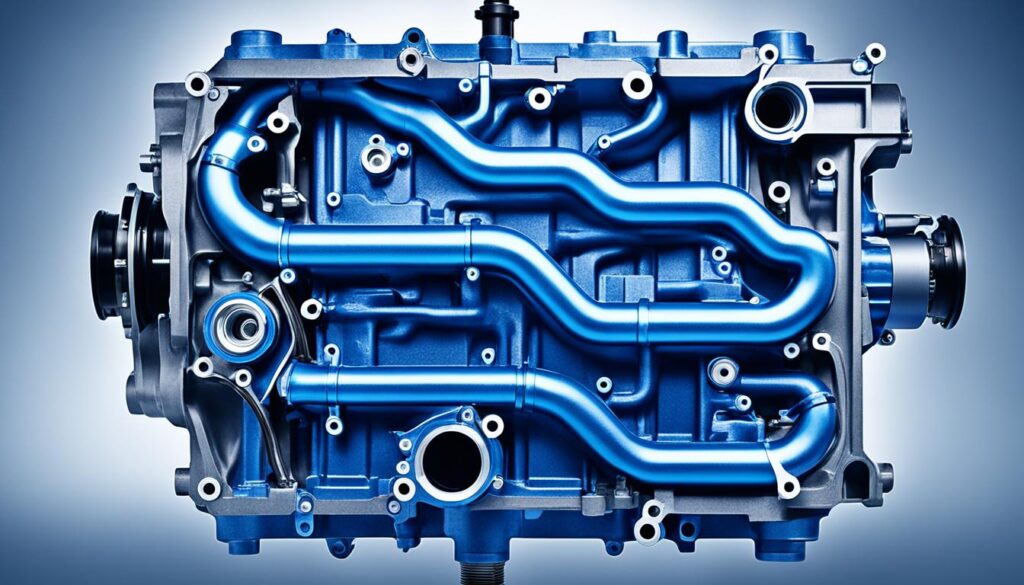The car’s water pump is key to keeping the engine cool. It moves coolant through the engine and other important parts. At the center of this system is the water pump housing. This strong part keeps the water pump safe and helps coolant flow well. We’ll explore why the water pump housing is so important for your car’s health and performance.
Key Takeaways
- The water pump housing is a critical component of the car’s cooling system, responsible for housing the water pump that circulates coolant through the engine.
- The housing is designed to protect the water pump and ensure efficient coolant flow, which is essential for proper engine temperature regulation.
- The materials used in the construction of the water pump housing, such as cast iron or aluminum, contribute to its durability and resistance to wear and tear.
- Regular inspection and maintenance of the water pump housing can help prevent costly engine repairs and ensure optimal engine performance.
- Understanding the role of the water pump housing is crucial for automotive enthusiasts and DIY mechanics looking to maintain and repair their vehicles.
Introduction to the Car Water Pump
The car water pump is key to an engine’s cooling system. It makes sure coolant moves around the system. Located at the engine’s front, it’s powered by the timing or serpentine belt. This keeps coolant flowing from the radiator to the engine and back.
Importance of the Car Water Pump
The car water pump is essential for keeping the engine at the right temperature. It keeps coolant moving to cool down the engine’s heat. This stops overheating and keeps the engine running smoothly.
Overview of the Water Pump’s Role
The car water pump’s main job is to keep coolant moving in the engine cooling system. This flow is key for dissipating heat and keeping the engine temperature right. It helps the vehicle’s cooling components work well and last longer.
| Component | Function |
|---|---|
| Car Water Pump | Circulates coolant through the engine cooling system |
| Radiator | Cools the heated coolant as it passes through |
| Thermostat | Regulates the temperature of the coolant entering the engine |
| Hoses | Transport the coolant between the various cooling system components |
Knowing how the car water pump works helps us see its importance. It’s a key part of the engine cooling system. It ensures the coolant keeps moving and the temperature stays in check. This is vital for the car to run well and last a long time.
Description of the Water Pump Housing
The water pump housing is key to a vehicle’s cooling system. It makes sure coolant moves well through the engine. This part is made with great care. It’s vital for keeping the engine at the right temperature and stopping it from getting too hot.
Materials Used for the Housing
The water pump housing is often made of cast iron or aluminum. Cast iron is strong and resists wear well. It’s a top choice for many cars. Aluminum is lighter, which helps save fuel. It also has the strength and protection against rust needed for the job.
Components Housed Within
- The impeller, a rotor with blades or vanes, pushes coolant through the engine and keeps the flow steady.
- The pulley, connected to the pump’s shaft, is driven by the engine’s belt. This makes the impeller spin at the right speed.
- The shaft, supported by bearings, links the impeller to the pulley. It helps the impeller rotate smoothly and reduces friction.
These internal water pump components work together to move coolant. They keep the engine at its best temperature. This helps avoid water pump housing construction problems that could cause the engine to overheat.
“The water pump housing is the unsung hero of the cooling system, quietly and efficiently doing its job to keep your engine running at its best.”
water pump housing
The water pump housing is key to a vehicle’s cooling system. It’s made to handle the engine’s tough conditions. Its design and construction are crucial for its durability and performance over time.
Design and Construction
The housing is often made of cast iron or aluminum. These materials can resist high temperatures and pressures. Inside, the impeller, shaft, and bearings work together efficiently with little wear.
The housing’s precise design helps the water pump circulate coolant well. This keeps the engine at the right temperature and prevents overheating. This shows the skill in making a reliable water pump.
Durability and Maintenance
A well-made water pump housing helps the pump last longer. Regular checks for leaks and coolant levels, and replacing belts, are key. This keeps the pump working well.
Looking after the maintenance needs of the water pump housing helps it last longer. This saves money on repairs or getting a new one later.
“Proper care and maintenance of the water pump housing is a key factor in ensuring the longevity and optimal performance of the entire cooling system.”
Functionality of the Water Pump
The water pump is key to the engine’s cooling system working well. It makes sure coolant keeps flowing through the engine. This helps control the engine’s temperature and stops it from getting too hot.
Coolant Circulation
The water pump’s impeller, powered by the engine, pulls coolant from the radiator. It then pushes it through the engine block and cylinder head. This keeps the coolant moving and helps it take heat away from the engine.
It then sends the heat to the radiator, where it cools down. This cycle is vital for keeping the engine at the right temperature. It also stops problems with the cooling system.
Engine Temperature Regulation
The water pump keeps the engine at the right temperature by moving coolant around. It draws coolant from the radiator and sends it through the engine. This helps control the engine’s temperature, preventing overheating and ensuring efficient combustion.
This is key for the engine’s performance and how long it lasts.
Knowing how the water pump works helps car owners understand its role in keeping the engine cool and healthy.

Signs of a Faulty Water Pump
The water pump is key to your car’s cooling system. It ensures the engine runs well. But, it can face problems over time. Knowing the signs of a failing water pump can prevent engine damage.
Coolant Leaks
A common sign of a bad water pump is coolant leaks. Seeing coolant puddles under your car or near the engine means the seals or gaskets are worn out. These leaks can cause coolant loss and engine overheating.
Overheating Engine
Overheating is another sign of a failing water pump. If your engine temperature gauge is too high or you see steam from the radiator, the pump might not be circulating coolant well. This can cause engine damage. So, it’s important to fix this quickly.
Other signs include strange noises from the engine’s front. Sounds like whining or grinding might mean the pump’s bearings or impeller are failing.
If you think your water pump is failing, get it checked by a mechanic. Ignoring it can lead to expensive repairs. Taking care of it early keeps your car’s cooling system running well.
Maintenance and Replacement
Keeping your car’s cooling system in good shape is key. Regular checks and professional care help your water pump work well. This prevents expensive repairs and keeps your engine running smoothly.
Regular Inspections
It’s vital to check your water pump often for any damage or wear. Look for coolant leaks, strange sounds, and make sure the coolant is at the right level. Also, check the belts that power the water pump. A broken belt can cause the pump to fail.
Professional Servicing
While checking your car yourself is good, getting a pro to look at your cooling system is a smart move. A skilled mechanic can spot issues and fix them early. This saves you from bigger problems and costs later.
“Maintaining your water pump is a small investment that can pay significant dividends in the long run, helping to avoid costly engine repairs and ensuring your vehicle’s cooling system operates at peak efficiency.”
Regular checks and professional help can make your car’s water pump last longer. This keeps your cooling system healthy. Taking care of it now saves you time, money, and stress later.

Cooling System Components Overview
The car’s cooling system is key to keeping the engine at the right temperature. It has many parts that work together to keep your car running well. Let’s look at the main parts and what they do.
The Radiator
The radiator is at the center of the cooling system. It cools down the engine’s heat by using coolant. This coolant goes through the radiator and cools down thanks to air flow. This air flow is helped by a fan clutch or an electric cooling fan.
The Thermostat
The thermostat is vital for controlling the engine’s temperature. It makes sure the engine stays at the best temperature. This keeps the car fuel-efficient and protects the engine from damage.
Hoses and Belts
Hoses carry coolant around the engine and radiator. They’re strong to handle the heat and pressure. Sometimes, a fan belt or serpentine belt powers the water pump. This pump keeps the coolant moving.
Fan Clutch and Electric Cooling Fan
The fan clutch helps control how much air goes through the radiator. Sometimes, an electric cooling fan kicks in to help keep the engine cool. This is when it needs extra cooling.
| Cooling System Component | Function |
|---|---|
| Radiator | Dissipates heat from the engine by cooling the circulating coolant |
| Thermostat | Regulates the engine’s operating temperature by controlling coolant flow |
| Hoses and Belts | Circulate the coolant throughout the engine and radiator |
| Fan Clutch and Electric Cooling Fan | Regulate airflow through the radiator to enhance cooling |
Knowing how each part of the cooling system works is key to keeping your car’s engine running well.
Conclusion
The water pump is key to keeping a vehicle’s engine cool. It makes sure coolant flows right and keeps the engine at the right temperature. Knowing how it works and how to take care of it helps avoid expensive repairs.
Checking it often, keeping it in good shape, and replacing it when needed are crucial. KT-Foundry gives us a detailed look at the water pump and the cooling system. This helps anyone keep their car running well.
Looking after the water pump and the cooling system is smart. It helps your car last longer, run better, and stay reliable. By keeping up with maintenance, we make sure the water pump does its job well. This leads to a smoother ride and better car performance.
FAQ
What is the purpose of the car water pump?
The car water pump keeps coolant flowing from the radiator to the engine and back. This helps the engine stay at the right temperature and prevents overheating.
What are the key components of the water pump housing?
The water pump housing has important parts like a housing, an impeller, a pulley, and a shaft with bearings.
What materials are used in the construction of the water pump housing?
It’s usually made of cast iron or aluminum. These materials are strong and can handle the engine’s high temperatures and pressures.
How does the water pump ensure proper circulation of the coolant?
The impeller in the pump spins to create a force that pushes coolant out through the pump’s outlet. This draws coolant from the radiator and sends it through the engine.
What are the common signs of a failing water pump?
Signs of a failing water pump include coolant leaks, engine overheating, strange noises, and steam from the radiator.
How can I maintain the car water pump?
Keep the pump in good shape by checking for wear or damage, making sure the coolant level and quality are right, and keeping the timing or serpentine belt in good condition.
What other components make up the vehicle’s cooling system?
The cooling system also has the radiator, thermostat, heater core, hoses, fan clutch, and electric cooling fan. Together, they help keep the engine at the right temperature.


